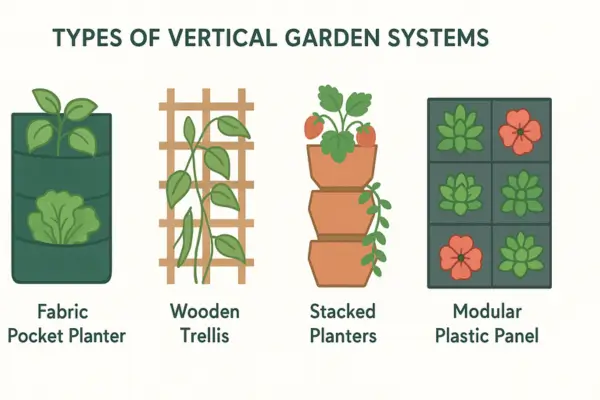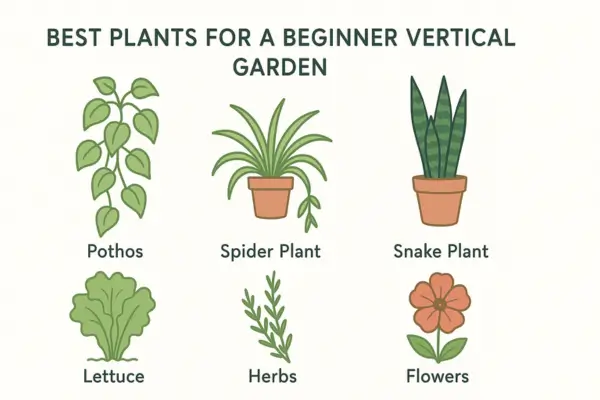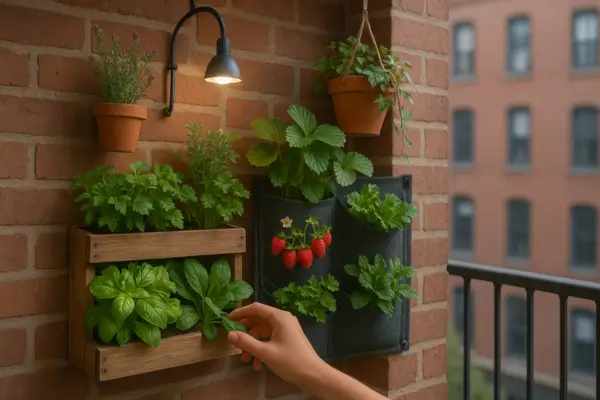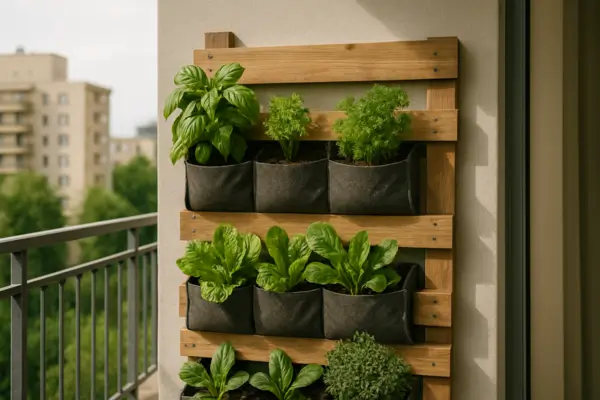Introduction
“Dreaming of a lush green wall but worried about maintenance? Discover the best plants for beginner-friendly vertical gardens!”
Vertical gardening is a brilliant way to grow plants upward on walls, trellises, or specially designed structures—perfect for small spaces, urban balconies, or even indoor décor. Whether you’re tight on ground space or simply want to add a stunning living wall to your home, vertical gardens offer a creative and efficient solution.
But if you’re new to gardening, the idea of maintaining a thriving vertical garden might seem intimidating. The good news? Some plants are practically foolproof—low-maintenance, fast-growing, and resilient enough to forgive beginner mistakes.
In this guide, we’ll explore the best plants for beginner-friendly vertical gardens, so you can enjoy a thriving green oasis with minimal effort. From fresh herbs and leafy greens to hardy succulents and vibrant flowers, these picks are perfect for first-time gardeners. Let’s dig in!
1- Why Start with Beginner-Friendly Plants?
If you’re new to vertical gardening, choosing the right plants can mean the difference between a thriving green wall and a frustrating flop. Beginner-friendly plants are like the training wheels of gardening—they’re forgiving, low-fuss, and designed to help you succeed. Here’s why they’re the perfect starting point:
1. Low Maintenance
No green thumb? No problem! Beginner plants tolerate imperfect care, like missed waterings or less-than-ideal light. They won’t throw a fit if you forget about them for a few days (looking at you, orchids).
2. Fast Growth = Instant Gratification
Waiting months for results can kill a new gardener’s enthusiasm. Fast-growing picks like basil, lettuce, or pothos give you visible progress in weeks, keeping you motivated to grow more.
3. Hardy & Pest-Resistant
Some plants attract pests or wilt at the first sign of trouble—not these troopers. Beginner-friendly varieties naturally resist common bugs and diseases, so you’ll spend less time battling aphids and more time enjoying your garden.
4. Adaptable to Any Space
Whether you’re growing on a sunny balcony or a dim apartment wall, these plants flex to your setup. Many thrive both indoors and outdoors, so you can experiment without stress.
Bottom Line: Starting with easy plants builds confidence and skills—so you can graduate to trickier varieties later. Now, let’s meet the best beginner plants for your vertical garden!
2-Top 15+ Best Plants for Beginner Vertical Gardens
Top 15+ Best Plants for Beginner Vertical Gardens
(Organized by Plant Type for Easy Growing Success)
Transform your walls into living art with these foolproof plants specially chosen for vertical gardening newbies. Each category offers unique benefits – from instant-gratification edibles to no-fuss beauties.
A. Easy Herbs for Vertical Edible Gardens
Perfect for: Kitchen walls, sunny balconies & fresh flavor lovers
- Basil
- Why You’ll Love It: Grows noticeably taller each day in warm weather
- Pro Tip: Snip leaves regularly to prevent flowering and encourage bushiness
- Bonus: Makes pesto in just 6-8 weeks from planting
- Mint
- Why It’s Foolproof: Survives underwatering but thrives with weekly drinks
- Key Advice: Always grow in containers – it will take over garden beds
- Fun Use: Add fresh sprigs to iced tea or mojitos
- Chives
- Beginner Perk: Comes back year after year in most climates
- Harvest Trick: Use scissors to cut what you need – regrows in days
- Bonus: Pretty purple flowers attract pollinators
- Oregano
- Why It’s Tough: Handles dry spells better than most herbs
- Best For: Italian dishes – flavor intensifies when dried
- Design Tip: Let it trail downward for a cascading effect
B. Leafy Greens (Fast & Nutritious)
Ideal for: Healthy eaters, small-space gardeners
- Lettuce (Butterhead/Looseleaf)
- Speed: Ready for “cut-and-come-again” harvests in 30 days
- Light Needs: One of few edibles that tolerates shade
- Space Saver: Grows well in shallow pockets
- Spinach
- Nutrition Star: Packed with iron and vitamins
- Cold Hardy: Withstands light frosts – great for early/late season
- Quick Tip: Harvest outer leaves first to prolong production
- Swiss Chard
- Visual Appeal: Rainbow stems brighten vertical spaces
- Dual Purpose: Both ornamental and edible
- Heat Tolerance: Lasts longer in summer than other greens
C. Foolproof Succulents & Air Cleaners
Best for: Forgetful waterers & indoor gardens
- Burro’s Tail
- Drought Score: 10/10 – stores water in plump leaves
- Style Points: Stunning trailing stems up to 3 feet long
- Care Secret: Loves to be root-bound
- Spider Plant
- Resilience: Bounces back from near-death experiences
- Air Power: Removes formaldehyde and xylene
- Bonus: Produces “babies” you can replant
- Pothos
- Light Flexibility: Grows in dark corners or bright rooms
- Growth Rate: Up to 12 inches per month in ideal conditions
- Styling Idea: Train vines to create living patterns
D. Colorful Flowers for Vertical Beauty
Perfect for: Instant curb appeal & pollinator friends
- Petunias
- Bloom Power: Flowers continuously from spring to frost
- Color Range: Every hue except true blue
- Design Trick: Mix colors for ombre effects
- Nasturtiums
- Edible Bonus: Peppery flowers jazz up salads
- Pest Control: Repels whiteflies and squash bugs
- Seed Saving: Easy to collect and replant next year
- Begonias
- Shade Champion: Blooms beautifully where other flowers fail
- Low Dust: Great for allergy sufferers
- Longevity: Individual flowers last weeks
E. Fast-Growing Climbers & Vines
Best for: Quick coverage & living privacy screens
- English Ivy
- Year-Round Interest: Evergreen in most zones
- Adaptability: Grows in sun or deep shade
- Historical Charm: Classic cottage garden look
- Sweet Potato Vine
- Visual Impact: Heart-shaped leaves in bold colors
- Speed: Covers 6 feet in a single season
- Versatility: Works in ground or containers
- Black-Eyed Susan Vine
- Cheer Factor: Sunny blooms all summer
- Vertical Reach: Climbs 6-8 feet with support
- Wildlife Bonus: Attracts butterflies
Pro Tip: Combine 2-3 types for instant visual interest – try “spillers” (like oregano) with “fillers” (like lettuce) and “thrillers” (like climbing nasturtiums).

3-Pro Tips for Beginner Vertical Garden Success
Vertical gardening is incredibly rewarding—but a few smart strategies can make the difference between a thriving green wall and a struggling setup. Whether you’re growing herbs, flowers, or veggies, these pro tips will help you succeed from the start.
1. Choose the Right System for Your Plants
Not all vertical gardens are created equal! Match your plants to the best structure:
✅ Pocket Planters – Ideal for herbs, small greens, and flowers (like basil, lettuce, or petunias).
✅ Trellises – Perfect for climbers (ivy, beans, or sweet potato vines).
✅ Stacked Planters – Great for strawberries, compact veggies, or cascading plants.
✅ Modular Panels – Versatile for mixed plantings (succulents + trailing flowers).
Pro Tip: Start small! A 2’x3′ panel or a few stacked planters are easier to manage than a full wall.
2. Watering Hacks to Keep Plants Happy
Vertical gardens dry out faster than ground-level beds. Avoid wilted plants with these tricks:
💧 Use Drip Irrigation – A timer-controlled system prevents underwatering.
💧 Self-Watering Planters – Great for beginners (less guesswork).
💧 Group Plants by Water Needs – Keep thirsty herbs (like mint) separate from drought-tolerant succulents.
💧 Check Soil Daily – Stick your finger 1″ deep—if dry, it’s time to water.
Warning: Overwatering kills more vertical gardens than neglect! Ensure proper drainage.
3. Light Requirements Made Simple
Sunlight = energy for growth. Position plants based on your wall’s exposure:
☀️ South-Facing Walls (Full Sun) – Best for herbs (basil, oregano), succulents, and fruiting plants.
⛅ East/West-Facing (Partial Sun) – Good for leafy greens (lettuce, spinach) and flowers (begonias).
🌑 North-Facing (Shade-Friendly) – Ideal for pothos, ferns, and mint.
Pro Tip: Rotate plants occasionally for even growth.
4. Soil & Fertilizer: The Foundation of Success
🚫 Avoid Garden Soil – Too heavy and may contain pests.
✅ Use Lightweight Potting Mix – Look for blends with perlite or coconut coir for drainage.
🌱 Feed with Slow-Release Fertilizer – Keeps plants nourished for months (great for busy gardeners).
Bonus: Add worm castings for a natural nutrient boost!
5. Avoid These Common Mistakes
❌ Ignoring Weight Limits – Wet soil + plants get heavy! Ensure your wall can support the load.
❌ Skipping Drainage Holes – Root rot is a silent killer.
❌ Overcrowding Plants – Give them space to breathe and grow.
Final Tip: Take weekly photos to track progress—it’s motivating!
Ready to Start?
Pick one system (pockets, trellis, or stacked planters), 3-5 beginner plants, and focus on consistent watering. You’ll have a lush vertical garden before you know it!
Need more help? drop a question in the comments!
4. Common Mistakes to Avoid (Save Your Vertical Garden!)
Even the most enthusiastic beginners can run into trouble—but these simple fixes will keep your vertical garden thriving. Avoid these top 3 pitfalls that sabotage new growers:
🚫 Mistake #1: Overwatering (The Silent Killer)
Why it’s deadly:
- Succulents (like burro’s tail) rot in soggy soil.
- Herbs (basil, oregano) develop weak roots if overwatered.
How to fix it:
👉 Check soil first – Stick your finger 1-2″ deep. If it’s damp, wait.
👉 Water deeply but less often – Better to drench thoroughly 2x/week than sprinkle daily.
👉 Use the “lift test” – Pots feel heavier when saturated.
Pro Tip: Self-watering planters with reservoirs prevent guesswork!
🚫 Mistake #2: Ignoring Spacing (The Crowding Catastrophe)
Why it backfires:
- Crowded plants compete for light and air.
- Trapped moisture invites mold and pests (like spider mites).
How to fix it:
👉 Follow seed packet/plant tag spacing – Yes, even in vertical gardens!
👉 Prioritize airflow – Leave room for leaves to spread (e.g., lettuce needs 6-8″ between plants).
👉 Trim aggressively – Remove yellowing leaves to prevent disease spread.
Design Trick: Mix one fast-growing plant (like nasturtiums) with slower growers (like succulents).
🚫 Mistake #3: Skipping Drainage (The Root Rot Trap)
Why it’s critical:
- Without drainage, roots drown in standing water.
- Fungal infections (like pythium) thrive in wet conditions.
How to fix it:
👉 Always use pots with holes – Drill your own if needed.
👉 Add a drainage layer – Place pebbles or charcoal at the base of planters.
👉 Elevate planters – Let excess water escape (use pot feet or a slatted shelf).
Emergency Save: If roots are mushy, repot in fresh soil and trim dead parts.
BONUS: 2 More Sneaky Mistakes
❌ Using Heavy Soil – Garden soil compacts in containers. Fix: Use lightweight potting mix.
❌ Forgetting to Fertilize – Vertical plants exhaust nutrients fast. Fix: Feed monthly with liquid seaweed.
Your Vertical Garden Checklist
✔ Water – Only when soil is dry 1-2″ down.
✔ Space – Give plants room to breathe.
✔ Drainage – Holes + well-draining soil = happy roots.
Remember: Even pros make mistakes—just adjust and keep growing! 🌱
Need help troubleshooting? Comment below with your garden questions!
5. Beginner Vertical Garden FAQs (Voice-Search Optimized!)
Got questions? We’ve got answers! These are the top queries beginners ask (and exactly how voice assistants like Siri or Alexa would answer them). Bookmark this section for quick troubleshooting!
🌿 Plant Selection FAQs
Q: “What’s the easiest plant for a vertical garden?”
A: For foolproof success, start with:
- Pothos (indoor/low light) – Thrives on neglect, purifies air.
- Mint (outdoor/sun) – Grows aggressively, even for forgetful waterers.
Pro Tip: Spider plants and sedum are also ultra-low-maintenance!
🥬 Edible Garden FAQs
Q: “Can I grow vegetables vertically?”
A: Absolutely! Try these space-saving veggies:
- Cherry tomatoes (use a trellis)
- Peas & beans (perfect for netting)
- Strawberries (great in stacked planters)
- Compact cucumbers (like ‘Bush Pickle’)
Avoid: Heavy veggies (like pumpkins) or deep-rooted plants (carrots).
💧 Care & Maintenance FAQs
Q: “How often should I water a vertical garden?”
A: The 1-inch rule never fails:
1️⃣ Press your finger into the soil up to the first knuckle.
2️⃣ If dry, water thoroughly until it drains out the bottom.
3️⃣ If damp, wait 1-2 days and check again.
Note: Vertical gardens dry out faster than pots! In summer, you may need to water daily.
🌞 Light & Location FAQs
Q: “Can vertical gardens grow indoors?”
A: Yes! Best indoor choices:
- Low light: Pothos, philodendron, snake plant
- Bright light: Herbs (basil, thyme), succulents
- Artificial light: Use LED grow lights 6-12 inches above plants.
🐛 Pest Control FAQs
Q: “How do I keep bugs off my vertical garden?”
A: Prevent pests naturally:
- Spray leaves with diluted neem oil (1 tsp per quart of water).
- Attract ladybugs – They eat aphids!
- Avoid overwatering – Fungus gnats love damp soil.
❄️ Seasonal FAQs
Q: “Can vertical gardens survive winter?”
A: Depends on your climate:
- Frost-free zones: Grow year-round (switch to cold-hardy plants like kale).
- Cold winters: Bring indoors or replant annually.
- Protect outdoor setups: Use burlap or frost cloth.
🔍 Troubleshooting Quick-Fix Table

Conclusion:
Your Beginner-Friendly Vertical Garden Awaits!
You’ve just discovered the best plants for vertical gardening success—whether you’re craving fresh herbs, crunchy greens, lush foliage, or vibrant blooms. Let’s recap your foolproof options:
✅ Herbs (Basil, Mint, Oregano) – For flavor and fast growth
✅ Leafy Greens (Lettuce, Spinach, Chard) – For quick, nutritious harvests
✅ Succulents & Air Purifiers (Pothos, Spider Plant) – For low-maintenance beauty
✅ Climbers & Flowers (Ivy, Petunias, Nasturtiums) – For vertical impact
Remember: Every gardening expert started exactly where you are now. Your first vertical garden doesn’t need to be perfect—it just needs to exist. Start with just 2-3 plants from this list, and let your confidence grow alongside them.
🌿 Your Next Steps
1️⃣ Pick your plants – Which ones made you nod excitedly? (I’m team “un-killable pothos” and “salad-ready lettuce”!)
2️⃣ Choose a system – Pocket planters for herbs? Trellis for climbers? Keep it simple.
3️⃣ Share your journey – Tag us on social with your progress—we’ll cheer you on!
👉 Start Today: Grab your supplies and plant something this weekend. Your future self will thank you!
Let’s Chat!
“Which plant are you most excited to grow? Any questions before you dig in? Drop a comment below—we love hearing from fellow plant lovers!”



